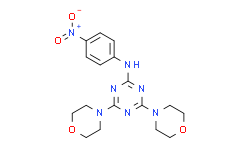| Cas No.: | 326914-06-1 |
| Chemical Name: | MHY1485 |
| Synonyms: | MHY1485;MHY-1485;4,6-Di-4-morpholinyl-N-(4-nitrophenyl)-1,3,5-triazin-2-amine;4,6-Dimorpholino-N-(4-nitrophenyl)-1,3,5-triazin-2-amine;4,6-Di(4-morpholinyl)-N-(4-nitrophenyl)-1,3,5-triazin-2-amine |
| SMILES: | O=[N+](C1=CC=C(NC2=NC(N3CCOCC3)=NC(N4CCOCC4)=N2)C=C1)[O-] |
| Formula: | C17N7O4H21 |
| M.Wt: | 387.3931 |
| Sotrage: | 2 years -20°C Powder, 2 weeks 4°C in DMSO, 6 months -80°C in DMSO |
| Description: | MHY1485 is a cell-permeable mTOR activator. MHY1485 has an inhibitory effect on the autophagic process by inhibition of fusion between autophagosomes and lysosomes. |
| In Vitro: | MHY1485 induces mTOR activity, which is another regulator of autophagy. MHY1485 markedly increases the LC3II/LC3I ratio dose-dependently and time-dependently[1]. An mTOR activator MHY1485 stimulates mTOR, S6K1 and rpS6 phosphorylation. Treatment with MHY1485 increases phospho-mTOR levels without affecting total mTOR content. MHY1485 treatment also increases the phosphorylation of downstream S6K1 and rpS6 proteins without affecting total S6K1 and rpS6 levels[2]. An mTOR activator, MHY1485, also abolishes the inhibitory effect of liraglutide on osteoblastic differentiation, and results in p-mTOR and TGF-β downregulation, but does not attenuate the liraglutide-induced increase in p-AMPK protein expression levels. Co-treatment with 4 nM Liraglutide and 1 µM MHY1485, an mTOR activator, results in protein expression levels of Alp, OC, p-mTOR and TGF-β and matrix mineralization comparable to those of positive control cells cells[3]. MHY1485 treatment increases ribosomal protein S6 kinase (S6K) and eukaryotic translation initiation factor 4E-binding protein 1 (4E-BP1) phosphorylation, which are downstream targets of mTOR complex 1 (mTORC1), but decreases phosphorylation of Akt on mTOR complex 2 (mTORC2) target site serine 473[4]. |

 To enhance service speed and avoid tariff delays, we've opened a US warehouse. All US orders ship directly from our US facility.
To enhance service speed and avoid tariff delays, we've opened a US warehouse. All US orders ship directly from our US facility.




















